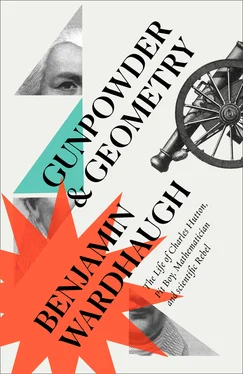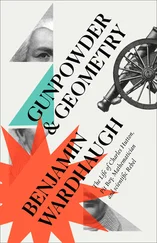We have few glimpses of that life. In one of his books Hutton, searching for a memorable image, remarked that a triangular prism ‘is something like a hat box’. Indeed it is: but hats in hat boxes were not a picture that would have sprung to Hutton’s mind a few years before. An admirer remarked much later that Hutton ‘was soon conscious of his great abilities, and claimed that rank in society to which they entitled him’. That was a polite gloss on the fact that material success gave him the means to act, dress, and for all practical purposes be middle-class. He was now indisputably the butterfly, not the caterpillar.
Still, he could not altogether avoid criticism. Some remembered ‘a very modest, shy man’ at this period; but we also hear of him knocking a boy down in the street while he was surveying Newcastle. In this or another incident someone taxed him with being only a pit boy, and Hutton retorted that if he – the critic – had been a pit boy he would be there still. Memories of the cap and gown lingered; two different witnesses, seventy years later, independently recalled the red cap.
There were three more children: Isabella, Camilla and Eleanor (known to her family as Ellen). They were baptised in the nonconformist chapel at Hanover Square.
At the time of writing Hanover Square is a demolition site tucked away near the line of the old town walls. Trains rattle past over the nearby viaduct, and it’s hard to get a sense of what was once Newcastle’s only open square. The chapel there was established in 1727; from 1767 it had a school, and by 1810, after some modification, it was large enough to hold an organ and six hundred people. Its congregation included prominent local poets, newspaper proprietors and politicians.
Hutton had remained a zealous Methodist for some time after his childhood conversion: one report says he wrote sermons and preached them, though if this is true they have – sadly – not survived. His connection with Hanover Square may mean he had now left behind a movement which at this date still aimed to reform the Church of England from within, not from without.
In fact the Hanover Square chapel would later acquire a reputation for Unitarianism, and Hutton’s presence there likely signals that he and his wife had come to be interested in more radical kinds of Protestant nonconformity, mixing in circles which questioned even such traditionally core doctrines as the Trinity, the atonement, and the divinity of Jesus. His private commitments are nowhere recorded, but a wider circle of Unitarians and those with radical sympathies – religious and political – would shape Hutton’s professional development long after he left Newcastle.
This could have had serious practical consequences. Probate courts, marriage, schools and universities all potentially discriminated against non-Anglicans, and the ill-named Toleration Act of 1688 specifically excluded deniers of the Trinity (as well as Catholics) from its provisions. Meanwhile the Blasphemy Act of 1698 threatened them with up to three years’ imprisonment and loss of civil rights. Enforcement was patchy, but the risk of penalties was real, as was that of the loss of friends. Hutton’s clerical benefactor Ivison is conspicuous by his absence from Hutton’s life after his move to Newcastle.

Work continued, and at a remarkable pace. Materially, Hutton was certainly prospering. His trajectory culminated for the moment with a final move to Westgate Street, one of Newcastle’s wealthier residential spots. He met the recurring problem of inadequate premises by acquiring a plot of land and building his own house and school. It was quite the elegant Georgian pile, with cellars and other conveniences. The Huttons could now avail themselves of all that the prosperous, growing city had to offer.
The old town walls (they had started to come down in 1763) enclosed an area of less than 200 acres, but those acres held the north of England’s capital and a good proportion of the northern counties’ population. There were tall elegant buildings and wide open spaces by the several churches. By the early 1770s the town had three hundred street lamps and a well-organised night watch. If the lower town tended to be smoky from house fires, and if the riverside was dominated by busy warehouses and the bustle of shipping on the Tyne (not to mention a growing concentration of poor tenements near the Black Gate), there were open fields just a little further up the hill, some under conversion into elegant pleasure gardens.

Newcastle in 1745.
The town offered the full range of mid-Georgian amenities. Subscription concerts, both at the assembly rooms and outdoors in the summer. Visits from famous musicians en route from London to Edinburgh, who would often stop and give a performance or two to offset the costs of travel. Charles Avison, Newcastle’s own resident composer and concert promoter, a man who enjoyed national fame. A literary club; theatres. Scientific lectures: Newcastle was the first provincial town to have them, with both local talents and the nationally famous visiting on tour. A popular press: for most of the century there were two weekly papers. Newcastle had local histories and local poets and balladeers. There were shops, inns, clubs, societies; fashion, food, wine.
Ultimately it all rested on coal; you could hardly forget that, if you lived anywhere near either the river or the coalfields, and Charles Hutton was never likely to forget it either. The sale of coal was so lucrative, contemporaries reckoned, that despite all the goods it imported Newcastle made a net gain every year, and had more money per head than anywhere else in the kingdom.
Mathematically, too, Newcastle and its environs were a rich world. There was William Emerson, a nationally famous mathematician who lived in nearby Hurworth. His studied eccentricity of manner and dress (home-made linen, big floppy hats and shapeless old jackets) earned him a local reputation as a wizard. Hutton corresponded with him and they became acquainted, though unsociable Emerson and ambitious Hutton did not really hit it off. There was John Fryer, who assisted Hutton with his surveying work; he was also Hutton’s teaching assistant at Westgate Street.
The school had its own separate entrance. Advertisements, briefer and more sober now, stated that there ‘Youth are qualified for the Army, Navy, Counting-house’; they could also be ‘compleatly instructed in the Theory and Practice of Land Surveying, with the use of the necessary Instruments’. Newcastle Grammar School took to sending its students to Hutton for specialist mathematics teaching. Not an altogether unusual arrangement – everyone knew that private academies did mathematics and science better than the grammar schools – but a gratifying endorsement of Hutton and his work.
His new-found middle-class status also meant that Hutton could work as a private tutor to the local gentry. As one biographer put it, Hutton’s ‘manners, as well as his talents’, now ‘rendered him acceptable’ in this role. Robert Shaftoe was one such patron, his home at Benwell Hall one of the more impressive local mansions (the Bobby Shaftoe of the popular song was a relative). Hutton’s tuition of his children impressed Shaftoe so much that he took to attending the lessons himself, revising the mathematics he had perhaps learnt at college. And he gave the young man the run of his impressive library. Newcastle had at least a couple of subscription libraries, and no shortage of booksellers, but access to a large, private book collection was a boon for Hutton, who remorselessly continued to improve himself. Over the years he added a reading knowledge of French, Italian and German to his early-acquired Latin. By 1772 he had read enough on geography to offer public lectures in the subject (to ‘gentlemen and ladies’) at half a guinea for the course. How many takers he found is not recorded.
Читать дальше














